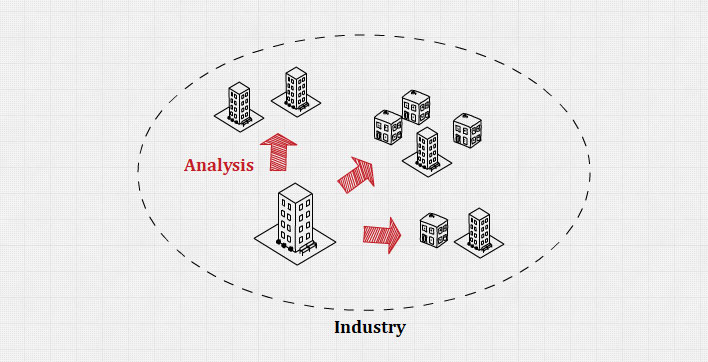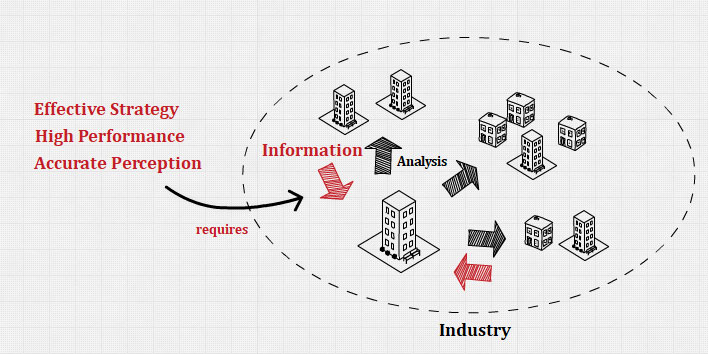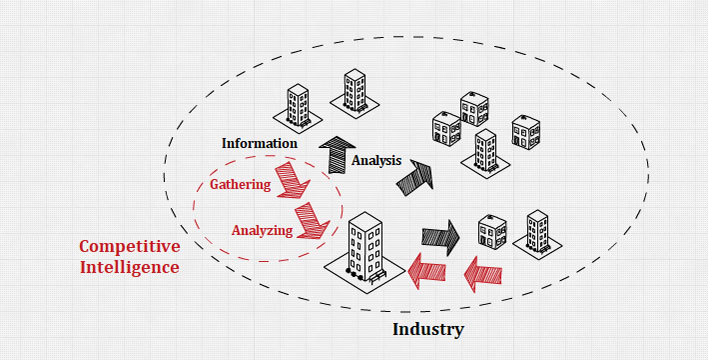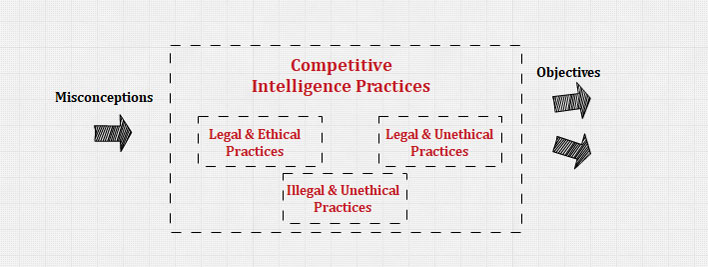What is Competitor Analysis?

Competitor analysis focuses on understanding, interpreting, and predicting competitors’ actions, responses, and intentions.
Intense rivalry creates a strong need to understand competitors. Understanding competitors’ actions and responses clearly contribute to the firm’s ability to compete successfully within the industry.
In competitor analysis, the firm seeks to understand the following: (1) What drives the competitor, as shown by its future objectives. (2) What the competitor is doing and can do, as revealed by its current strategy. (3) What the competitor believes about the industry, as shown by its assumptions. (4) What the competitor’s capabilities are, as shown by its strengths and weaknesses.
Knowledge about these four dimensions helps the firm prepare an anticipated response profile for each competitor.
Market commonality and resource similarity are 2 concepts that can be utilized in competitor analysis.
Market commonality can be defined as the number and significance of markets that a firm competes with rivals. Resource similarity is the extent to which the type and amount of a firm’s internal resources are comparable to a rival.
Why is Competitive Intelligence Important?

Reason 1: The more information and knowledge a firm can get about its competitors, the more likely it is that it can formulate and implement effective strategies.
Identifying rival firms and determining their strengths, weaknesses, capabilities, opportunities, threats, objectives, and strategies are essential for a successful organization.
Major competitors’ weaknesses can represent external opportunities; major competitors’ strengths may represent key threats. Improved capabilities of competitors are a critical strength factor contributing to the increasing competitive intensity in any industry.
Competitive information is applicable and useful for making decisions in many steps of strategic planning, including strategy formulation, implementation, and evaluation and control.
Reason 2: Gathering data and information that can help the firm understand its competitors’ intentions and the strategic implications resulting from them is critical to effective competitor analysis.
In competitor analysis, the firm gathers extensive intelligence about its competitors. Such intelligence facilitates an understanding of the strategic posture of the competitors. Through effective competitive and public policy intelligence, the firm gains the insights needed to make effective strategic decisions regarding how to compete against these rivals.
Reason 3: Generally, there is a very strong association between corporate performance and competitive intelligence activities.
Firms need an effective competitive intelligence (CI) program. A good CI program in business is one of the keys to success. An effective CI program allows all areas of a firm to access consistent and verifiable information in making decisions. All members of an organization, from the chief executive officer to custodians, are valuable intelligence agents and should feel themselves to be a part of the CI process. This phenomenon, in general, facilities better corporate performance.
Reason 4: Without competitive intelligence, organizations are at risk of flying blind in the market. Firms can gain many advantages simply because their rivals have either incorrect or no perception about them.
Any direct discussions with a competitor about price, market, or geography intentions could violate antitrust statutes. However, this fact must not lure a firm into underestimating the need for and benefits of systematically collecting information about competitors.
Proper competitive intelligence represents a set of valuable data and information the firm can gather to better understand and anticipate competitors’ objectives, strategies, assumptions, and capabilities.
What is Competitive Intelligence?

Competitive intelligence (CI), as formally defined by the Society of Competitive Intelligence Professionals (SCIP), is a systematic and ethical process for gathering and analyzing information about the competition’s activities and general business trends to further a business’s own goals.
The primary activity of competitive intelligence is to monitor competitors, which are organizations that offer the same, similar, or substitutable products or services in the business area in which a particular company operates.
Done right, competitive intelligence will be one of the most critical key inputs to external environment scanning and in turn strategic planning.
What Makes a Successful CI Program?

The 3 basic objectives of a successful CI program are:
- To provide a general understanding and awareness of an industry and its competitors,
- To identify areas in which competitors are vulnerable and to assess the impact strategic actions would have on competitors, and
- To identify potential moves that a competitor might make that would endanger a firm’s position in the market.
Misconceptions about CI and CI Programs

There are 3 strong misperceptions about competitive intelligence that prevail in modern business.
- Running an intelligence program requires lots of people, computers, and other resources.
- Collecting intelligence about competitors violates antitrust laws; business intelligence equals espionage.
- Intelligence gathering is an unethical business practice.
Companies usually face these challenges in deciding how to gather intelligence about competitors while simultaneously determining how to prevent competitors from learning too much about them. To deal with these challenges, firms should establish principles and take practices that are consistent with them.
Legal and Ethical Competitive Intelligence Practices

There are several major practices regarding competitive intelligence that firms may adopt, which are (1) practices that are both legal and ethical, (2) practices that are legal, but arguably unethical, and (3) practices that are illegal and unethical.
Practices considered both legal and ethical include:
Practice 1: Obtaining publicly available information from suppliers, customers, publications, employees, experts, or industry conferences. Firms use multiple sources as their competitive intelligence source (e.g., business publications, court records, competitors’ advertisements, annual reports, newspaper articles, government filings, results of academic research and public polls, or financial reports of publicly held corporations.)
Most companies utilize outside organizations to provide them with this environmental data. Most of these collection activities are done on an informal and individual basis.
The Internet has also become an excellent medium for these collection activities. Information that is gathered can make the difference between having superior or just average intelligence and overall competitiveness. However, online information is also filled with noise, misinformation, and utter nonsense. This creates a serious problem for researchers and strategists in searching and evaluating useful information.
Many business corporations have established their own libraries and information systems to deal with the massive growth of available information. Management can use this information to spot regional and national trends as well as to assess market share.
Practice 2: Attending trade fairs to obtain competitors’ brochures, view their exhibits, and listen to discussions about their products. Usually held by industry experts, these shows offer perfect opportunities to find out more information about competitors.
Practice 3: Following codes of professional practice and ethics. Professional associations are available to firms as sources of information regarding competitive intelligence practices. These associations offer codes of professional practice and ethics to firms for their possible use when deciding how to gather competitive intelligence.
Legality is based on written laws and regulations, whereas ethics is based on human rights and wrongs. Firms must follow relevant laws and regulations as well as carefully articulated ethical guidelines when gathering competitor intelligence.
Practices considered legal, but a firm must decide whether they are also ethical, include:
Practice 1: Opening discussions of intelligence gathering techniques. This practice can help a firm ensure that employees, customers, suppliers, and even potential competitors understand its convictions to follow ethical practices when gathering intelligence about its competitors.
Practice 2: Following an appropriate guideline for competitor intelligence practices. This is about respecting the principles of common morality and the right of competitors not to reveal certain information about their products, operations, and intentions.
These competitive intelligence practices may be legal, but a firm must decide whether they are also ethical, given the image it desires as a corporate citizen. Sometimes, the line between legal and ethical practices can be difficult to determine.
Practices considered both illegal and unethical include:
Practice 1: Blackmail, which is a form of criminal activity that uses threats to force competitors to act against their interests. This can be an attempt from firms to obtain proprietary information by threatening to publicize information that would incriminate or socially damage a competitor.
Practice 2: Trespassing, which means to enter a competitor’s building or infrastructure and access their files without proper permissions. The firms can steal drawings, samples, documents, or computer hard drives.
Practice 3: Eavesdropping or wiretapping, which is an act of connecting a device to a telephone line in order to secretly monitor conversations and acquire valuable competitive information.
Practice 4: Bribery, which means to offer illegal remuneration in various forms of financial compensation to top managers or employees of competitors, in exchange for proprietary information and intelligence data.
Practice 5: Job poaching, where certain organizations may use current or former competitors’ employees or private contractors to attempt to steal secrets, technology, business plans, and other strategic information.
Governments in certain countries have passed laws and regulations to combat these unethical behaviors in acquiring competitive information.
Competitive Intelligence, Spying, or Corporate Espionage?

The line between competitive intelligence, competitive spying, or corporate espionage is usually not clear. What is considered ethical by one may not be for another, be it a person, a firm, or a country. The rules of engagement to follow when gathering competitive intelligence change in different contexts.
Corporate espionage, also called industrial espionage, competitive spying, or corporate spying, is a practice to acquire private intelligence about a competitor, using practices that are either illegal, unethical, or both.
Competitive intelligence is an activity that appears to involve trade-offs. Firms can avoid the possibility of legal entanglements and ethical quandaries only when their competitive intelligence gathering methods are governed by a strict set of legal and ethical guidelines.
Ethical behavior and actions, as well as the mandates of relevant laws and regulations, should be the foundation on which a firm’s competitive intelligence gathering process is formed.
Resources
Further Reading
- Competitive Intelligence (investopedia.com)
- What is Competitive Intelligence? (fuld.com)
- What is Competitive Intelligence? (fletchercsi.com)
- What is Competitive Intelligence? (visualping.io)
- How to Practice Ethical Competitive Intelligence (crayon.co)
- Ethical Collection of Competitive Intelligence (competitivefutures.com)
- How to keep your competitive intelligence legal (and ethical) (kompyte.com)
Related Concepts
References
- Hill, C. W. L., & Jones, G. R. (2011). Essentials of Strategic Management (Available Titles CourseMate) (3rd ed.). Cengage Learning.
- Hitt, M. A., Ireland, D. R., & Hoskisson, R. E. (2016). Strategic Management: Concepts: Competitiveness and Globalization (12th ed.). Cengage Learning.
- Hitt, M. A., Ireland, D. R., & Hoskisson, R. E. (2019). Strategic Management: Concepts and Cases: Competitiveness and Globalization (MindTap Course List) (13th ed.). Cengage Learning.